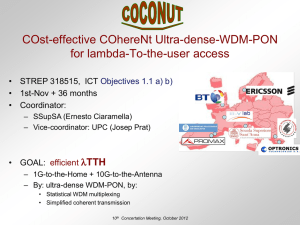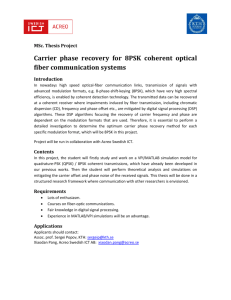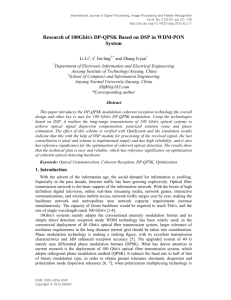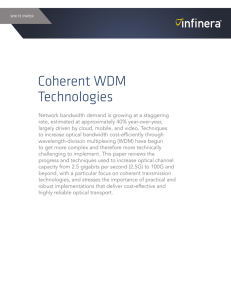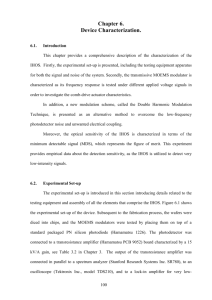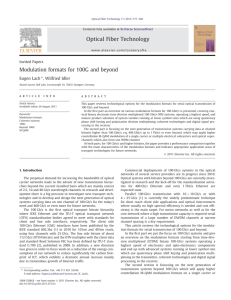Phase Suppression in Coherent Optical Communications
advertisement
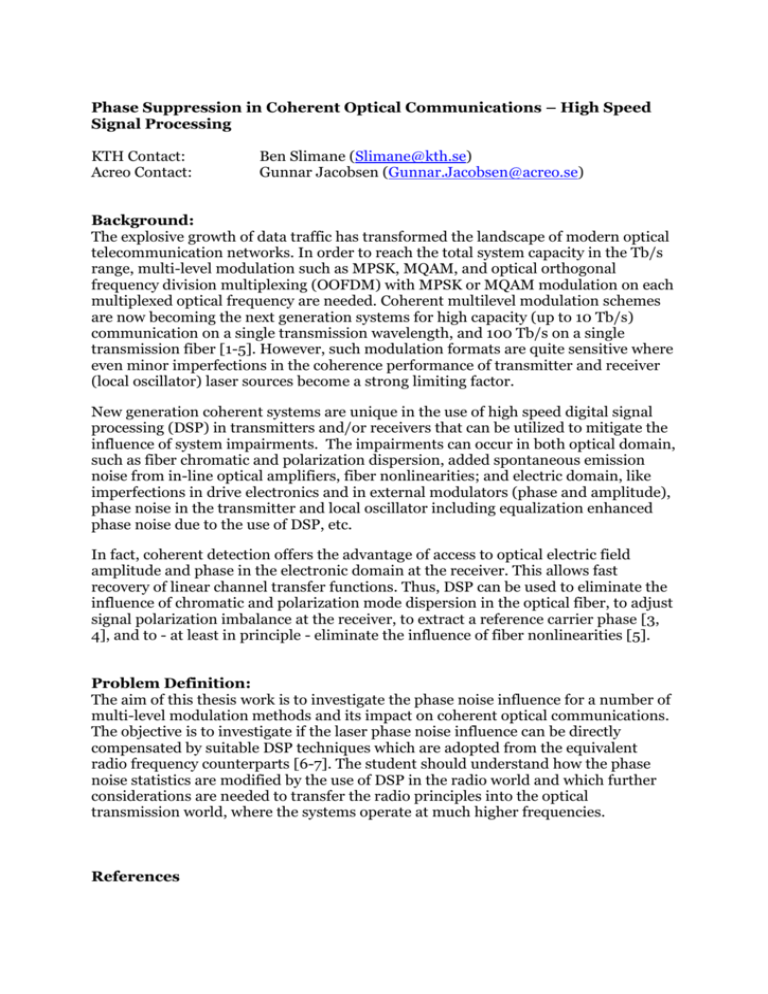
Phase Suppression in Coherent Optical Communications – High Speed Signal Processing KTH Contact: Acreo Contact: Ben Slimane (Slimane@kth.se) Gunnar Jacobsen (Gunnar.Jacobsen@acreo.se) Background: The explosive growth of data traffic has transformed the landscape of modern optical telecommunication networks. In order to reach the total system capacity in the Tb/s range, multi-level modulation such as MPSK, MQAM, and optical orthogonal frequency division multiplexing (OOFDM) with MPSK or MQAM modulation on each multiplexed optical frequency are needed. Coherent multilevel modulation schemes are now becoming the next generation systems for high capacity (up to 10 Tb/s) communication on a single transmission wavelength, and 100 Tb/s on a single transmission fiber [1-5]. However, such modulation formats are quite sensitive where even minor imperfections in the coherence performance of transmitter and receiver (local oscillator) laser sources become a strong limiting factor. New generation coherent systems are unique in the use of high speed digital signal processing (DSP) in transmitters and/or receivers that can be utilized to mitigate the influence of system impairments. The impairments can occur in both optical domain, such as fiber chromatic and polarization dispersion, added spontaneous emission noise from in-line optical amplifiers, fiber nonlinearities; and electric domain, like imperfections in drive electronics and in external modulators (phase and amplitude), phase noise in the transmitter and local oscillator including equalization enhanced phase noise due to the use of DSP, etc. In fact, coherent detection offers the advantage of access to optical electric field amplitude and phase in the electronic domain at the receiver. This allows fast recovery of linear channel transfer functions. Thus, DSP can be used to eliminate the influence of chromatic and polarization mode dispersion in the optical fiber, to adjust signal polarization imbalance at the receiver, to extract a reference carrier phase [3, 4], and to - at least in principle - eliminate the influence of fiber nonlinearities [5]. Problem Definition: The aim of this thesis work is to investigate the phase noise influence for a number of multi-level modulation methods and its impact on coherent optical communications. The objective is to investigate if the laser phase noise influence can be directly compensated by suitable DSP techniques which are adopted from the equivalent radio frequency counterparts [6-7]. The student should understand how the phase noise statistics are modified by the use of DSP in the radio world and which further considerations are needed to transfer the radio principles into the optical transmission world, where the systems operate at much higher frequencies. References 1. J. Yu et al., ``Generation, Transmission and Coherent Detection of 11.2 Tb/s (112x100Gb/s) Single Source Optical OFDM Super channel,’’ Proceedings OFC2011, post deadline paper PDPA6 2. T. Richter et al., ``Single Wavelength Channel 10.2 Tb/s TDM Data Capacity using 16QAM and coherent detection,’’ Proceedings OFC2011, post deadline paper PDPA9 3. T. Xu, G. Jacobsen, S. Popov, J. Li, E. Vanin, K. Wang, A. T. Friberg and Y. Zhang, ``Chromatic dispersion compensation in coherent transmission system using digital filters,’’ Opt. Express 18, 16243-16257 (2010). [8] 4. M. G. Taylor, ``Phase estimation methods for optical coherent detection using digital signal processing,’’ J. Lightwave Technol. 17, 901-914 (2009). 5. D. S. Ly-Gagnon, S. Tsukamoto, K. Katoh, and K. Kikuchi, ``Coherent detection of optical quadrature phase-shift keying signals with carrier phase estimation,’’ J. Lightwave Technol. 24, 12-21 (2006). 6. P. Pedrosa et al., ``Bayesian approach for the estimation of phase noise in scfde schemes,’’ IEEE Globecom 2011, pp. 1-5, 2012 7. K. Sathananthan, R.M.A.P. Rajatheva, and S. Ben Slimane, ``Cancellation technique to reduce inter-carrier interference in OFDM,’’ IEE Electronics Letters, Vol. 36, No. 25, pp. 2078-2079, December 2000.

